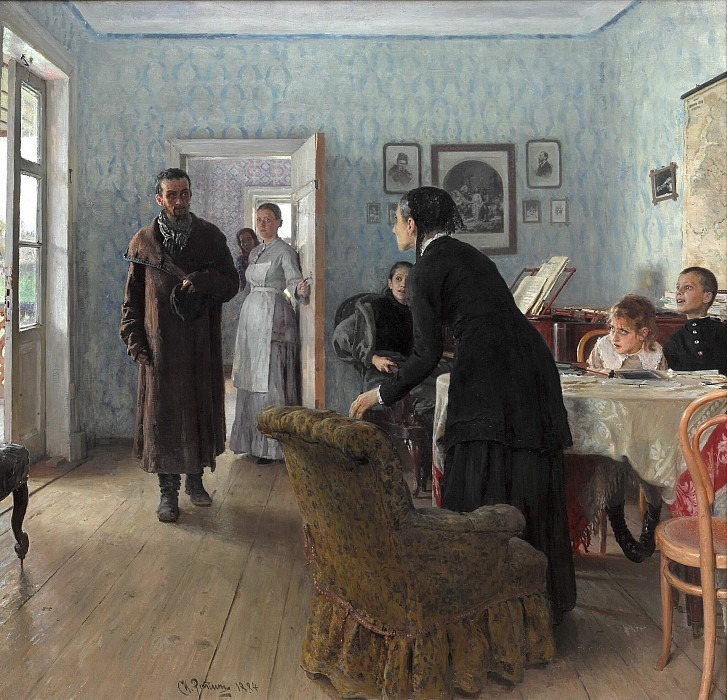Did not wait (Unexpected) Ilya Repin (1844-1930)
Ilya Repin – Did not wait (Unexpected)
Edit attribution
Download full size: 2048×1973 px (0,4 Mb)
Painter: Ilya Repin
Location: The State Tretyakov Gallery, Moscow (Государственная Третьяковская галерея).
This painting depicts the unexpected return of a revolutionary who had been exiled. The artist sought to convey the pause that arose between the arrival and the household. It is not so much the moment of appearance that is important, but rather the moment of surprise, which was very accurately conveyed on the canvas. This pause is so well emphasized that, in the silent silence, the family simply can’t believe their eyes.
Description of Ilya Repin’s painting "Not Waiting"
This painting depicts the unexpected return of a revolutionary who had been exiled. The artist sought to convey the pause that arose between the arrival and the household.
It is not so much the moment of appearance that is important, but rather the moment of surprise, which was very accurately conveyed on the canvas. This pause is so well emphasized that, in the silent silence, the family simply can’t believe their eyes. This state of shock and belief merges together, emphasizing the importance of this fugitive to the people who love him.
Everyone knows quite clearly what happens next, but the author has chosen to leave the presentation of these emotions to each individual. In the prisoner’s gaze one can see sadness and weariness, a plea for acceptance and forgiveness, a prayer for leniency and repentance.
An elderly woman, rising to meet him, gazes at the arrival, searching for the painfully familiar features and voice, the native features of her son. Still not believing the miracle and not giving up hope, the woman’s trembling hand seeks support from the back of her chair. Dressed in mourning, the woman mentally buried her son, but in her heart she never stopped believing.
Though the woman was visible from the back, it did not prevent her from understanding the extent to which grief had made her change - gray hair with a glimmer of white, a slightly shriveled figure, slumped shoulders, and prematurely arrived old age.
The others in the painting are also family members, but it is the exile’s family - his wife and children, who, without hiding their delight and hope, are preparing to burst into tears, not believing in the return of their loved one. The little girl’s fear is clearly portrayed and, enveloped by a feeling of joy, the boy is about to throw himself on his father’s neck.
The image of his wife, too, shows us a genuine story of the hero’s feelings and former life. The woman is portrayed as pale, exhausted, confused and frightened, yet joyful.
In order to clearly separate the exile and the rest of the family, the artist depicted him as a darker figure, which against the background of home comfort, the usual course of life, rushes in like a cold wind in the days of May. But at the same time the exile is not sure whether his family will accept him now that he has become a fugitive and a convict, whether they will understand his motives that prompted him to go against everyone.
So the newcomer stands in the middle of the room, not daring to take a step into the house or back out into the street. There is hope lingering in him.
Кому понравилось
Пожалуйста, подождите
На эту операцию может потребоваться несколько секунд.
Информация появится в новом окне,
если открытие новых окон не запрещено в настройках вашего браузера.
You need to login
Для работы с коллекциями – пожалуйста, войдите в аккаунт (open in new window).

















COMMENTS: 1 Ответы
Картина Репина «Не ждали» соединяет в себе черты бытового жанра с историческим. Проблема общественного и личного долга находит здесь сложное психологическое решение. Типичная интеллигентная семья показана в привычной для неё будничной обстановке. Неожиданное возвращение ссыльного революционера приводит в минутное замешательство всех присутствующих.
С большим психологическим мастерством передана вся сложность чувств и переживаний. Здесь и порыв матери, и затаённая радость жены, и ликование сына, и испуг девочки, и выжидание прислуги. Выразительная характеристика каждого персонажа создаёт образы выпуклые и ярко индивидуальные. Избирая для своей картины такой момент развития действия, когда кульминация должна наступить через несколько мгновений, Репин держит зрителя в напряжённом ожидании, предоставляя ему возможность самому домыслить завершение ситуации.
Подчёркивая неожиданность событий, художник отдельными деталями (сдвинутое на переднем плане кресло, срезанные краем картины кресло и стул) создаёт впечатление жизненной случайности и естественности положений. Однако вся композиция картины даёт чёткую логическую конструкцию, в которой расположение фигур и предметов строго уравновешено.
Мастерски решена цветовая гамма полотна. Общая просветлённая тональность придаёт драматической сцене лирическую окраску. Колорит становится ключом к оптимистическому решению темы. Так бытовая картина, воплощающая революционную тему, в трактовке Репина перерастает рамки обычного жанра, превращаясь в картину историческую.
You cannot comment Why?
Around the table are a few children, one boy and a girl, who are looking with mixed expressions of surprise and curiosity towards the woman or where shes indicating. Another younger girl sits behind the woman, also observing the scene.
The room is furnished with a piano or a similar instrument, a patterned wallpaper, and a large armchair in the foreground. The overall atmosphere is one of unexpected arrival or a dramatic revelation.
The subtext of the painting likely revolves around the theme of The Unexpected. The mans sudden appearance could be that of a long-lost relative, someone returning from a journey, or an unwelcome guest. The womans animated reaction suggests she is either surprised by his arrival or by something he has said or revealed. The childrens reactions further emphasize the element of surprise and perhaps a bit of apprehension or excitement. The title itself, Did not wait (Unexpected), directly points to a situation that was not anticipated, creating a sense of drama and narrative tension within the seemingly calm domestic environment.